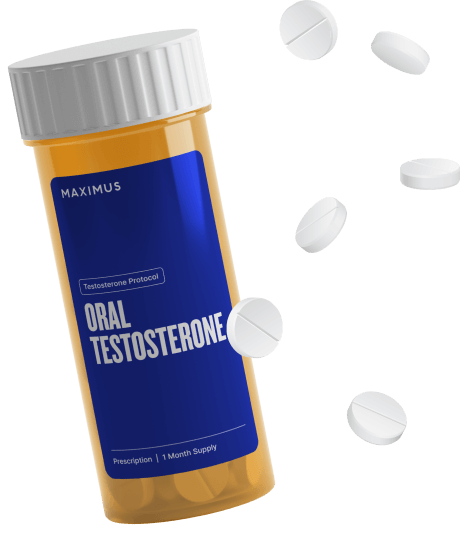Oral Testosterone
Liver Enzyme Trends in Patients Using Maximus’ Oral Native Testosterone: A Retrospective Analysis

Gabriel Alizaidy, M.D., M.S.1; S. Cameron Sepah, Ph.D.1,2; Starling Krentz, M.S.1
1. Maximus, Los Angeles, CA, United States
2. University of California, San Francisco, Department of Psychiatry, San Francisco, CA, United States
Corresponding Author:
S. Cameron Sepah, Ph.D.
Email: cam@maximustribe.com
Abstract
Background: Oral testosterone was historically avoided due to hepatotoxicity linked to early 17-alpha-alkylated formulations. Modern lipid-based delivery systems, including testosterone undecanoate, have demonstrated hepatic safety through lymphatic absorption. However, data on unmodified oral native testosterone remain limited, particularly in long-term use.
Objective: To evaluate changes in liver enzyme values over 90 days in patients using oral native testosterone, focusing on alanine aminotransferase (ALT) and gamma-glutamyl transferase (GGT) as markers of hepatic function.
Methods: A retrospective review was conducted on 100 patients prescribed oral native testosterone. Blood samples were collected using at-home testing kits. Due to assay limitations, ALT and GGT were measured pre- and post-treatment. AST was excluded. The Wilcoxon Signed Rank test was used to assess paired changes, and a subgroup analysis was performed on patients with elevated baseline liver enzymes.
Results: Across the full cohort, average individual changes in ALT (–0.56 U/L) and GGT (–1.21 U/L) were not statistically significant (p = 0.9025 and p = 0.1184, respectively). In patients with elevated baseline ALT or GGT, enzyme levels decreased significantly: ALT from 62.78 to 44.67 U/L (p = 0.027) and GGT from 84.43 to 70.14 U/L (p = 0.016). No hepatic adverse events were reported. The average increase in total testosterone was 505 ng/dL, with post-treatment values averaging 991 ng/dL.
Conclusion: Over a 90-day period, oral native testosterone did not elevate liver enzymes in this cohort. In patients with elevated baseline markers, statistically significant reductions were observed. These findings confirm the hepatic safety of oral native testosterone and establish it as a safe and effective option for testosterone therapy.
↓
Reduction in ALT (in patients with elevated baseline)
↓
Reduction in GGT (in patients with elevated baseline)
↔
Hepatic adverse events reported
↑
Average total testosterone post-treatment
Background
Oral testosterone has historically been avoided in clinical practice due to concerns about liver toxicity. Early formulations such as methyltestosterone were chemically modified to resist hepatic metabolism through 17-alpha alkylation. While this modification improved oral bioavailability, it also introduced hepatotoxicity risks, including cholestatic jaundice, altered liver function tests, and in rare cases, hepatocellular carcinoma and peliosis hepatitis.1
As a result, oral testosterone use declined for several decades. Interest returned with the development of testosterone undecanoate, a formulation that uses the lymphatic system to avoid first-pass liver metabolism. Multiple studies have confirmed the hepatic safety of testosterone undecanoate, showing no consistent evidence of liver enzyme elevation or hepatotoxic injury.2
Since undecanoate is a modified form of testosterone, it is reasonable to expect that native, unesterified testosterone delivered through a similar route would also be safe for the liver. Native testosterone lacks ester chains and other structural modifications. However, most research on native oral testosterone has focused on single-dose pharmacokinetics, and long-term hepatic safety data remain limited.3
Objective
This study aimed to evaluate changes in liver enzyme values in patients using oral native testosterone over a 90-day period. The primary focus was on alanine aminotransferase (ALT) and gamma-glutamyl transferase (GGT) as indicators of hepatic function.
Methods
A retrospective analysis was conducted on exactly 100 patients who were prescribed oral native testosterone and monitored through an at-home blood collection system. Due to constraints on blood volume and the availability of CLIA-waived assays, only ALT and GGT were measured. Aspartate aminotransferase (AST) was not included.
ALT, AST, and GGT are commonly used serum enzymes for evaluating liver injury and assessing hepatic function.4 Although AST is frequently part of liver panels, it is also found in skeletal muscle and cardiac tissue. ALT, while more liver-specific, like AST, may also rise temporarily after exercise.5 This makes interpretation of either enzyme difficult in isolation, especially in active patients. In contrast, GGT is minimally influenced by exercise and other non-hepatic factors. When used together, ALT and GGT can provide a reliable assessment of liver-specific stress in outpatient and remote testing settings.
Reference ranges were based on Mayo Clinic guidelines, which define the upper normal limit as 55 U/L for ALT and 51 U/L for GGT.6 Blood values were collected at least 90 days apart. Serum testosterone levels were also measured to assess treatment response (see Table 1).
Descriptive Statistics for 100 Patients Pre- and Post-Treatment with Maximus Oral Native Testosterone
| Category | Average | Range |
|---|---|---|
| Age | 43 Years | 23–75 |
| Treatment Duration | 95 Days | 37–193 |
| Pre Treatment Testosterone (T) | 485 ng/dL | 145–954 |
| Post Treatment Testosterone (T) | 991 ng/dL | 701–1500 |
| Pre Treatment ALT (Liver Enzyme) | 30 U/L | 8–81 |
| Post Treatment ALT | 30 U/L | 14–73 |
| Pre Treatment GGT (Liver Enzyme) | 26 U/L | 6–134 |
| Post Treatment GGT | 25 U/L | 7–122 |
To determine the appropriate statistical test, we assessed data normality using the Shapiro-Wilk test. Because the data were not normally distributed, we used the Wilcoxon Signed Rank test to compare pre- and post-treatment enzyme levels. A subgroup analysis was also conducted on patients with ALT or GGT values above the normal range at baseline.
Results
Among the 100 patients in the study, the average individual change in ALT was -0.56 U/L and in GGT was -1.21 U/L. These changes were not statistically significant. The p-values were 0.9025 for ALT and 0.1184 for GGT (see Table 2). No evidence of liver enzyme elevation or hepatic injury was observed in the overall cohort.
Wilcoxon Signed-Rank Test Results: ALT and GGT
| Marker | Average Individual Change | Wilcoxon Test Statistic | p-value | Interpretation |
|---|---|---|---|---|
| ALT | -0.56 U/L | 2294.5 | 0.9025 | No statistically significant change. |
| GGT | -1.21 U/L | 1583.5 | 0.1184 | No statistically significant change. |
In the subgroup of patients with elevated baseline enzyme values, ALT decreased from 62.78 to 44.67 U/L, and GGT decreased from 84.43 to 70.14 U/L. Both reductions were statistically significant. No adverse hepatic events were reported. Details of this subgroup analysis are summarized in Table 3a and Table 3b.
ALT Levels in Patients with Elevated Baseline ALT
| Variable | Value |
|---|---|
| Patients | 9 |
| Pre-Treatment (Mean ± SD) | 62.78 ± 7.84 U/L |
| Post-Treatment (Mean ± SD) | 44.67 ± 15.54 U/L |
| Wilcoxon Statistic (W) | 6 |
| p-value | 0.027 |
| Interpretation | Statistically significant reduction; mean ↓ 18.11 U/L |
GGT Levels in Patients with Elevated Baseline GGT
| Variable | Value |
|---|---|
| Patients | 7 |
| Pre-Treatment (Mean ± SD) | 84.43 ± 29.12 U/L |
| Post-Treatment (Mean ± SD) | 70.14 ± 31.17 U/L |
| Wilcoxon Statistic (W) | 2 |
| p-value | 0.016 |
| Interpretation | Statistically significant reduction; mean ↓ 14.29 U/L |
Treatment effectiveness was confirmed by increases in serum testosterone. The average individual increase was 505 ng/dL, with a post-treatment mean of 991 ng/dL. In total, 37 percent of patients reached levels above 1000 ng/dL, and 25 percent exceeded 1123 ng/dL. A full summary of testosterone outcomes is provided in Table 4.
Maximus Oral Native Testosterone Treatment Outcomes Summary
| Metric | Value |
|---|---|
| Average Pre-Treatment Testosterone | 485 ng/dL |
| Average Post-Treatment Testosterone | 991 ng/dL |
| Average Individual Change | 505 ng/dL |
| Statistical Significance (Wilcoxon Test p-value) | < 0.001 |
| Percentage of Patients >1000 ng/dL Post-Treatment | 37.00% |
| Distribution of Testosterone Levels Pre-Treatment | Q1: 353, Q2: 470, Q3: 611 |
| Distribution of Testosterone Levels Post-Treatment | Q1: 794, Q2: 924, Q3: 1123 |
Discussion
This study found no evidence of hepatic injury after 90 days of oral native testosterone use. Liver enzyme levels remained stable across the overall cohort and improved significantly in patients who began with elevated values. These results align with prior data on testosterone undecanoate, which has consistently demonstrated a favorable liver safety profile. Native testosterone, being structurally simpler and bioidentical to the hormone naturally produced by the body, is metabolized through established pathways without the need to process ester chains or chemical modifications. Combined with its absorption through the lymphatic system, it would be expected to pose even less hepatic risk. This analysis supports that conclusion.
Conclusion
In a sample of 100 patients treated with oral native testosterone, no increases in ALT or GGT were observed over a 90-day period. Patients with elevated liver enzymes at baseline demonstrated statistically significant improvement. These findings confirm the hepatic safety of oral native testosterone and establish it as a viable option for testosterone therapy.
References
- Amneal Pharmaceuticals. Methyl Testosterone Capsules, USP, CIII (10 mg) [Prescribing Information]. Bridgewater, NJ: Amneal Pharmaceuticals; May 2019.
- Goldstein I, Chidambaram N, Dobs A, et al. Newer formulations of oral testosterone undecanoate: development and liver side effects. Sex Med Rev. 2024;qeae062. doi:10.1093/sxmrev/qeae062
- Newell-Price J, Huatan H, Quirke J, et al. An oral lipidic native testosterone formulation that is absorbed independent of food. Eur J Endocrinol. 2021;185(5):607–615. doi:10.1530/EJE-21-0606
- Lala V, Zubair M, Minter DA. Liver Function Tests. [Updated 2023 Jul 30]. In: StatPearls [Internet]. Treasure Island (FL): StatPearls Publishing; 2025 Jan-. Available from: https://www.ncbi.nlm.nih.gov/books/NBK482489/
- Tiller NB, Stringer WW. Exercise-induced increases in "liver function tests" in a healthy adult male: Is there a knowledge gap in primary care? J Family Med Prim Care. 2023;12(1):177–180. doi:10.4103/jfmpc.jfmpc_1923_22
- Mayo Clinic. Liver function tests. Published 2023. Accessed May 4, 2025. https://www.mayoclinic.org/tests-procedures/liver-function-tests/about/pac-20394595






